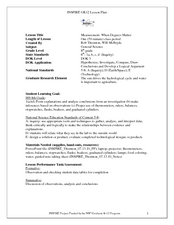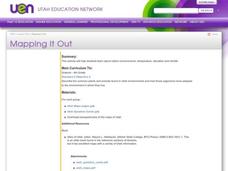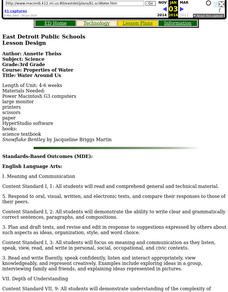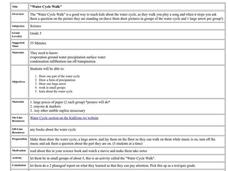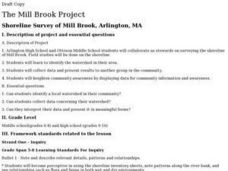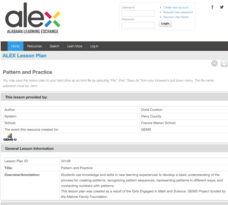Curated OER
Measurement: When Degrees Matter
Eighth graders record the temperature change of the beakers. In this general science activity, 8th graders create their own data table for recording observations. They discuss experimental results and cite real life applications.
Curated OER
Work-Kinetic Energy Theorem
Students prove the validity of the Work-Kinetic Energy Theorem by analyzing the Car and Driver website which lists qualitative and quantitative data about an assigned car. They decide whether or not they would purchase the car based on...
Curated OER
The Effects of Ultra-Violet Light on Yeast
Pupils work in small groups collecting and analyzing data as they learn how to best grow yeast. This lesson allows students to conduct several student-created experiments as they continually generate questions and hypotheses. ...
Curated OER
This is Your Rock, This is My Rock
Fourth graders review the types of rocks and minerals they see in photographs. Individually, they are shown a sample of rocks or minerals and classify them based on their characteristics. They give their observations to another...
Curated OER
Scientific Inquiry: Periodic Motion
Learners construct their own pendulum. In this physics lesson plan, students design an experiment to find the factors affecting its period. They formulate a conclusion based on experimental data.
Curated OER
Mapping It Out
Fourth graders examine various aspects of the environment of Utah. In groups, they create four maps of Utah, based on temperature, precipitation and elevation. To end the lesson, they are asked a question as a group and use their maps...
Curated OER
Who Wants to be a Cellular Biologist?
Eighth graders review concepts in cellular biology. In this biology lesson, 8th graders play an interactive game based on the idea of winning money. They discuss misconceptions about the topic.
Curated OER
Factoring Out Disease
High schoolers identify and discuss health problems that can occur during adulthood. They research one health problem, list the risk factors of the disease, and create a Powerpoint presentation based on their research.
Curated OER
John Muir - Around the World in 76 Years
Sixth graders create timelines of John Muir's life while playing a game based on John Muir's travels. They discover that John Muir traveled around the world to compare and contrast natural phenomena and to speak out about preserving...
Curated OER
It's Hot
Third graders examine the effect of sunlight on the earth. Individually, they pick an article of clothing out of a bag and sort themselves based on the color of the shirt and whether it should be worn on a cold or a hot day. To end the...
Curated OER
Water Around Us
Third graders learn the effects of temperature on the states of water. Then students create paper snowflakes. Finally students complete a computer project with software which teaches the different states of water.
Curated OER
Virus Alert
Ninth graders explore the various types and replication patterns of viruses. Using an interactive web-based textbook, 9th graders research viruses and their replication patterns. When their research is complete, students use a drawing...
Curated OER
Water Cycle Walk
Young scholars investigate the water cycle. In this water cycle lesson, students listen to a song as they walk around and when they music stops, they answer a question based on the water cycle.
Curated OER
Lâlâkea Stream: Diversion and Restoration
Students research the history of the Lalakea stream diversion and restoration. They examine the restoration project from multiple viewpoints and consider how it affects the stream-related environments.
Curated OER
Insect Monitoring
Students practice the scientific method in the classroom, either in preparation or as a substitution for real-world field experience. They examine a simulated biodiversity research situation, using a "mini-plot" or
sampling square...
Curated OER
Inside/Outside the Human Genome
Students combine a jigsaw learning technique with an inside/outside review game to learn about genes and the Human Genome Project. Students will describe DNA, genes and chromosomes.
Curated OER
The Study of Urban and Suburban Environments within the Mystic River Watershed
High school students examine their own water-based environments, within the Mystic Watershed. As the learners engage in inquiry-based, hands-on projects, critical thinking skills and problem-solving, the project will lead them to cross...
Curated OER
Building a Volcano
Young scholars research volcanoes and then build one out of salt dough. Before the final step is completed, they find main ideas about volcanoes, write sequential steps to building, use correct grammar, to gain knowledge about them. ...
Curated OER
Motel of Mysteries
Students determine that even though inferences are based on observations that does not mean they are always true or correct. They pull the topics and main ideas out of a piece of difficult text.
Curated OER
I Have a Metaphor
Learners locate the literary devices used in Martin Luther King Jr.'s "I Have a Dream" speech. In this figurative language lesson plan, students first distinguish between similes, metaphors, analogies, personification, etc. Learners...
Curated OER
The Artemia Hatchery
Students, in groups, develop their hatcheries, working cooperatively in its design and construction. The lessons begin with the introduction to Artemia as a primary food source of many aquaculture species during their larval stages.
Alabama Learning Exchange
Tiger Math Graphing
Learners practice various skills using the book Tiger Math: Learning to Graph from a Baby Tiger. After listening to the story, they create a pictograph using data collected from the text. They also color a picture of a tiger,...
Curated OER
Explore More About Bottle Construction
Students explore Green Construction. In this lesson based on the experiences of Peace Corps volunteers, students gain insight into alternative construction in Guatemala. They examine the pros and cons of using alternative building...
Alabama Learning Exchange
Pattern and Practice
Young scholars learn how to make patterns. Students first display their prior knowledge of patterns before delving into the lesson. They complete a worksheet and participate in a web-based class activity. They work in cooperative groups...


